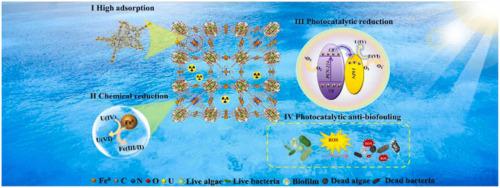Journal of Hazardous Materials ( IF 12.2 ) Pub Date : 2022-09-19 , DOI: 10.1016/j.jhazmat.2022.130018 Jing Zhao 1 , Chaoyi Lyu 1 , Rui Zhang 1 , Yao Han 1 , Yundi Wu 2 , Xilong Wu 3

|
The expansion of large-scale nuclear power causes a substantial volume of radioactive wastewater containing uranium to be released into the environment. Because of uranium's toxicity and bioaccumulation, it is critical to develop the efficient and sustainable materials for selective removal of uranium (VI). Herein, a regenerable anti-biofouling nano zero-valent iron doped porphyrinic zirconium metal–organic framework (NZVI@PCN-224) heterojunction system was successfully fabricated. Due to the Schottky-junction effect at the NZVI/MOF interface, the NZVI nanomaterial immobilized on PCN-224 could improve interfacial electron transfer and separation efficiency, and enhance entire reduction of highly soluble U(VI) to less soluble U(IV), involving photocatalytic reduction and chemical reduction. Meanwhile, the photocatalytic effect also prompts the NZVI@PCN-224 to produce more biotoxic reactive oxygen species (ROS), resulting in high anti-microbial and anti-algae activities. Under dark conditions, NZVI@PCN-224 with a large specific surface area could provide sufficient oxo atoms as the uranium binding sites and show the highest uranium-adsorbing capability of 57.94 mg/g at pH 4.0. After eight adsorption-desorption cycles, NZVI@PCN-224 still retained a high uranium adsorption capacity of 47.98 mg/g and elimination efficiency (91.72%). This sorption/reduction/anti-biofouling synergistic strategy of combining chelation, chemical reduction and photocatalytic performance inspires new insights for highly efficient treatment of liquid radioactive waste.
中文翻译:

自清洁可再生纳米零价铁改性 PCN-224 异质结用于光增强放射性废物减量
大规模核电的扩张导致大量含铀的放射性废水被释放到环境中。由于铀的毒性和生物蓄积性,开发用于选择性去除铀 (VI) 的高效且可持续的材料至关重要。在此,成功制备了一种可再生的抗生物污染纳米零价铁掺杂卟啉锆金属-有机骨架(NZVI@PCN-224)异质结系统。由于 NZVI/MOF 界面的肖特基结效应,固定在 PCN-224 上的 NZVI 纳米材料可以提高界面电子转移和分离效率,并促进高可溶性 U(VI) 完全还原为难溶性 U(IV),包括光催化还原和化学还原。同时,光催化作用还促使 NZVI@PCN-224 产生更多具有生物毒性的活性氧(ROS),从而产生高抗微生物和抗藻类活性。在黑暗条件下,具有大比表面积的 NZVI@PCN-224 可以提供足够的氧原子作为铀结合位点,并在 pH 4.0 时显示出 57.94 mg/g 的最高铀吸附能力。经过八次吸附-解吸循环后,NZVI@PCN-224 仍然保持了 47.98 mg/g 的高铀吸附容量和消除效率(91.72%)。这种结合螯合、化学还原和光催化性能的吸附/还原/抗生物污染协同策略激发了对液体放射性废物高效处理的新见解。从而产生高抗微生物和抗藻类活性。在黑暗条件下,具有大比表面积的 NZVI@PCN-224 可以提供足够的氧原子作为铀结合位点,并在 pH 4.0 时显示出 57.94 mg/g 的最高铀吸附能力。经过八次吸附-解吸循环后,NZVI@PCN-224 仍然保持了 47.98 mg/g 的高铀吸附容量和消除效率(91.72%)。这种结合螯合、化学还原和光催化性能的吸附/还原/抗生物污染协同策略激发了对液体放射性废物高效处理的新见解。从而产生高抗微生物和抗藻类活性。在黑暗条件下,具有大比表面积的 NZVI@PCN-224 可以提供足够的氧原子作为铀结合位点,并在 pH 4.0 时显示出 57.94 mg/g 的最高铀吸附能力。经过八次吸附-解吸循环后,NZVI@PCN-224 仍然保持了 47.98 mg/g 的高铀吸附容量和消除效率(91.72%)。这种结合螯合、化学还原和光催化性能的吸附/还原/抗生物污染协同策略激发了对液体放射性废物高效处理的新见解。pH 4.0 时为 94 毫克/克。经过八次吸附-解吸循环后,NZVI@PCN-224 仍然保持了 47.98 mg/g 的高铀吸附容量和消除效率(91.72%)。这种结合螯合、化学还原和光催化性能的吸附/还原/抗生物污染协同策略激发了对液体放射性废物高效处理的新见解。pH 4.0 时为 94 毫克/克。经过八次吸附-解吸循环后,NZVI@PCN-224 仍然保持了 47.98 mg/g 的高铀吸附容量和消除效率(91.72%)。这种结合螯合、化学还原和光催化性能的吸附/还原/抗生物污染协同策略激发了对液体放射性废物高效处理的新见解。











































 京公网安备 11010802027423号
京公网安备 11010802027423号